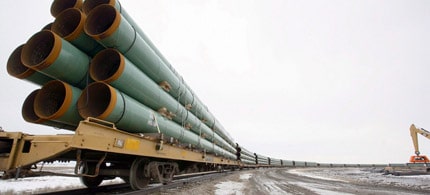On Monday, the State Department’s public comment period closed for the Keystone XL pipeline draft environmental impact statement. Over one million comments were submitted by citizens opposed to the tar sands pipeline. Then came the most damning comment of them all: from the Environmental Protection Agency.
The EPA submitted a letter faulting the State Department’s environmental review of the Keystone XL pipeline for being “insufficient” and raising “Environmental Objections” to the project.
If this sounds familiar, it’s because the very same thing happened roughly two years ago, when the State Department was first assessing the proposed tar sands pipeline project.
In June of 2011, the EPA first wrote to criticize the draft environmental impact statement as “insufficient.”
That EPA letter certainly played a part – as did sustained grassroots advocacy efforts, exposes on conflicts of interest between State and the pipeline’s profiteers, and relentless debunking of false jobs and energy security promises – in the State Department’s move to punt the decision for a year, take a fresh look at the proposals, and go back to the drawing board to create a new supplemental environmental impact statement.
State released the new draft supplemental environmental impact statement (SEIS) in March. It must be noted that it was conducted by firms connected to companies involved in tar sands production. The EPA was compelled under the National Environmental Policy Act (NEPA) and the Clean Air Act to review the statement and offer expert feedback.
The agency was not satisfied with the new supplemental review, calling it “insufficient” and recommending a number of major revisions to the analysis. On top of the “insufficient” categorization, the EPA gave the proposed project an “Environmental Objections” rating, which is their technical speak for a project that would have significant environmental impacts. In fact, such a designation is extremely rare, and NRDC’s Anthony Swift puts it in perspective:
The importance [of] this rating cannot be overstated – EPA’s stance rating of environmental reviews offers the most compelling expert opinion of whether the process was done well and its conclusions were sound. Moreover, the Administration’s EO rating for Keystone XL is in stark contrast to State’s – only about 5% of draft environmental reviews get ratings of EO or worse, indicating that the project will have significant environmental impacts.
So what exactly did the E.P.A. find issue with in the new draft SEIS?
Cynthia Giles, the assistant administrator for the E.P.A.’s Office of Enforcement and Compliance Assurance and author of the agency’s letter, raised concerns about these specific assumptions:
- That Keystone XL wouldn’t impact tar sands development: The report “regarding energy markets, while informative, is not based on an updated energy-economic modeling effort… This analysis should include further investigation of rail capacity and costs, recognizing the potential for much higher per barrel rail shipment costs than presented in the” draft assessment.
- That greenhouse gas emissions from tar sands crude are only 17-percent higher than conventional crude: The EPA analysis contends that “the difference may be even greater depending on the assumptions made.”
- That tar sands crude spills are treated like conventional oil spills: Having dealt with Enbridge’s Kalamazoo River spill for the past two years, the E.P.A. wrote that dilbit spills “may require different response actions or equipment” than regular crude. Additionally, the E.P.A. argues that effects on public and environmental health are different because tar sands crude does “not appreciably biodegrade.” Giles recommended that State needs to “more clearly acknowledge that in the event of a spill to water, it is possible that large portions of dilbit will sink and that submerged oil significantly changes spill response and impacts.”
- That alternative routes were well assessed: The E.P.A. is “concerned… that the DSEIS does not provide a detailed analysis of the Keystone Corridor Alternative routes.”
Jim Murphy, senior counsel for the National Wildlife Federation, said of the E.P.A.’s letter, “The Environmental Protection Agency’s letter shows that despite multiple tries, the State Department is incapable of doing a proper analysis of the climate, wildlife, clean water, safety and other impacts of this disastrous and unneeded project.”
With over one million comments criticizing the draft SEIS, and this massive condemnation from a fellow federal agency, the State Department should feel compelled to go back to the drawing board yet again.
Perhaps this time it will rely less on consulting firms with strong fossil fuel industry ties, and work to produce a valid environmental impact statement that accurately depicts the severe environmental and climate impacts of tar sands expansion and the increased likelihood of dilbit spills on American land and into American waterways.
Subscribe to our newsletter
Stay up to date with DeSmog news and alerts






